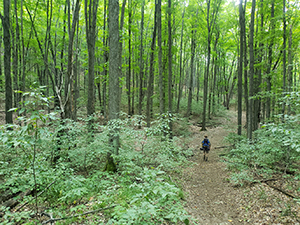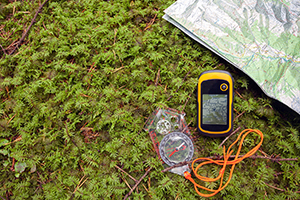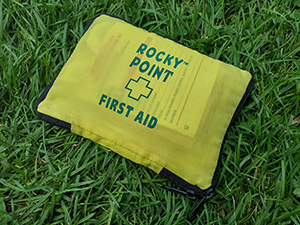Have the best day outdoors by preparing for the worst
Difference between a great day in the forest and a scary one comes down to planning
By RACHEL COALE
Michigan Department of Natural Resources
Ron Swanson, a fictional character from the quirky TV comedy “Parks and Rec,” is known for his firm ideas about enjoying the outdoors: “There is no such thing as bad weather, only inadequate clothing and means of transportation.”
We’re inclined to agree with the spirit of his statement, although we don’t recommend hitting the trail in stormy weather.
Preparing for everything from a bee sting to a bear sighting is the best way to have an enjoyable adventure, especially if you’re heading into the wilder side of Michigan’s public lands – state forests.

State forests are rugged areas with few amenities, smaller crowds than other outdoor attractions and more to explore. How much more? Michigan’s state forests, at 3.85 million acres, have more than six times the space of our state parks and game areas combined.
State forests are mostly located in the Upper Peninsula and northern Lower Peninsula – “knuckles north” on your trusty Michigan mitten hand-map.
For some, these areas are a peaceful place to connect with nature, while for others, they offer a thrilling challenge to hike, mountain bike or horseback ride.
Here’s the lowdown on preparing for some of the hazards you might face on a state forest adventure. The list includes all-around tips for newbies who are just getting started and reminders for veteran outdoor enthusiasts to restock their kits.
Short on time? Check out this National Park Service video on the 10 essentials you need to bring to the outdoors.
Navigation, illumination and preparation
|

Repeat after us: a cellphone is not a map. On the trail – and especially if you’re roaming off-trail – it’s important to bring a physical map of the area. If possible, laminate it or store it in a waterproof sleeve. Cellphone reception can be hit or miss in the forest, so you don’t want to rely on your phone as your only means of navigation.
The same goes for light – carry a real flashlight rather than depending on your phone’s. Many flashlight models come with a hand-crank charging option, and some even double as cellphone chargers.
Before hitting the trail, let a friend or family member know where and when you plan to explore. It’s also a good idea to leave a hike plan folded up on the seat of your car.
You might have to work on readying yourself for outdoor adventure. Know your physical ability and work up to the level of activity you’re planning. That could mean preparing by taking long walks around your neighborhood, hitting the elliptical at the gym or practicing strength training moves like squats, calf raises and lunges to prepare to carry a loaded pack.
Gear up
|

It may seem absurd, but we’ve seen it – wearing flip-flops to hike in the forest is asking for trouble.
Michigan Department of Natural Resources forester Cheryl Nelson logs many field hours as part of the DNR’s forest health team. She recommends investing in sturdy, closed-toe hiking boots.
“It’s better to spend a little more on boots that will last,” Nelson said.
She recommends making sure the boots are comfortable and fitted for all-day hikes.
“After a few hours of hiking, your feet will swell slightly, so if they’re tight already, it will make them really uncomfortable,” she added.
If your adventure leads to rocky or hilly areas, hiking poles can boost your stability.
A packable raincoat is also a must – they weigh just a few ounces and take up very little space, but will make a huge difference if a storm rolls in. On the other end of the weather spectrum is sun protection. Sunglasses, a hat with a brim and sunscreen will help prevent overheating and painful sunburns.
An emergency tarp/shelter, fire-starting materials and a knife or multitool are recommended if you’re venturing off the beaten path where you’ll be hard to find if you get stranded.
Before heading out, check the weather forecast for storm and wildland fire risk. Both hazards have the potential to move across the landscape nearly as quickly as the wind can carry them.
|
Avoid injuries, dehydration and “hangries”

Nothing is worse than getting out to that gorgeous waterfall, scenic overlook or grove of old-growth trees and feeling it hit – that grumpy, hungry feeling known as “the hangries,” knowing you need to hike the whole way back.
Even on a day hike, extra water and high-energy snacks are important to pack. Protein bars, jerky, dried fruit, tuna pouches and classic trail mix are nutrient-dense, lightweight options.
Even more important than food is water – drink up, and drink often. The key to staying hydrated is to make water accessible. Keeping it somewhere easy to grab will encourage you to drink frequently. A hydration flask with a hose is more expensive than a bottle but is a great investment if you plan on being outdoors often.
If there’s no place at your destination to refill with safe, drinkable water, be sure to bring a way to purify it; pump systems or purifying tablets are both good options. Never drink water straight out of a stream, pond or lake without treating it first. It’s tempting when a body of water looks pristine, but there’s no way of telling what kinds of tiny bacteria may be lurking inside.
In the outdoors, cuts, scrapes and bug bites happen. A basic first-aid kit is vital. It should include items like bandages, pain relief, antihistamines, tweezers, blister tape and antiseptic wipes. It should also have any medication you or a member of your group may need on hand, such as an EpiPen or insulin.
|
In the wild, expect wildlife

Charge up your camera – Michigan’s forests are full of amazing wildlife. Hundreds of animal species inhabit our state, including 160 kinds of freshwater fish and about 350 types of birds. On an adventure, you might spot an elk in the Pigeon River Country State Forest, a family of foxes up in the rocky hills of the Keweenaw Peninsula or a majestic bald eagle soaring over a Great Lakes coastal wetland.
While you’re snapping those Instagram photos, remember to keep wildlife wild. Keep a safe distance. Don’t attempt to pet animals and leave all creatures outdoors where they’ll be happiest and healthiest. Just quietly appreciate the gift of seeing them in their natural habitat.
It’s unlikely, but if you are approached by an aggressive animal, stand tall and speak in a loud, confident voice to encourage it to leave. BearSmart.com has tips for what to do if you encounter a bear on the trail.
In addition to Michigan’s many birds, fish and other animals, there are also an estimated 15,000 species of native insects. Many of them, like swallowtail butterflies or woolly bear caterpillars, are fun to encounter.
Others, like horseflies, ticks and mosquitoes … are not. In the woods, you need protection, not just from itchy, nasty bites, but also from the potential for infection. Bug sprays containing DEET, picaridin, lemon-eucalyptus oil and permethrin are the most effective picks for warding off biting bugs.
“Tick bites are a real concern,” said DNR safety coordinator Jan Hebekeuser. “During the summer tick season, we remind staff to wear long pants and apply insect repellent whenever they’re in the field.”
Visit the Centers for Disease Control and Prevention’s tick information webpage for tips to avoid tick bites and what to do if you think you’ve been bitten.
|
Check out previous Showcasing the DNR stories in our archive at Michigan.gov/DNRStories. To subscribe to upcoming Showcasing articles, sign up for free email delivery at Michigan.gov/DNR.
Get out there

Our list may seem like it has a lot of items, but a well-fitting day pack should be able to accommodate everything with room to spare. If you never need the emergency shelter or first-aid kit, that’s great, but if you do, you won’t regret bringing them.
Now that you’re packed, the forest is waiting. Find public forest land at Michigan.gov/StateForests. Use our interactive map to find a forest near you and build your adventure checklist. Here are a few places to start:
- Need a paved trail? Check out majestic, old-growth white pines and get a history lesson at Hartwick Pines Visitor Center and Logging Museum.
- Looking for a rugged adventure? Gear up and tackle the High Country Pathway, a seven-day backpacking trail that takes hikers through the heart of Michigan’s elk country.
- How about a day hike? Try the Algonquin Pathway, a 9-mile, nonmotorized hiking and biking trail near Sault Ste. Marie, for a trip through gorgeous hardwood and conifer forests.
Wherever you go, your careful preparations will help you feel confident so you can have your best adventure in Michigan’s beautiful outdoors.
Check out previous Showcasing the DNR stories in our archive at Michigan.gov/DNRStories. To subscribe to upcoming Showcasing articles, sign up for free email delivery at Michigan.gov/DNR.
|
/Note to editors: Contact: John Pepin, Showcasing the DNR series editor, 906-226-1352. Accompanying photos and a text-only version of this story are available below for download. Caption information follows. Credit Michigan Department of Natural Resources, unless otherwise noted.
Text-only version of this story.
Caterpillar: Some of Michigan’s estimated 15,000 species of native insects – like this woolly bear caterpillar – are fun to encounter, but outdoor adventurers need insect repellent to protect against biting bugs like ticks, mosquitoes and horseflies.
Elk: Michigan forests are filled with a wide range of wildlife, like the elk that can be found in northern Lower Peninsula locations like the Pigeon River Country State Forest.
Forest: With 3.85 million acres to explore, Michigan’s state forests offer ample opportunity to get away from crowds and connect with nature. Pictured here is Sand Lakes Quiet Area pathway, located within the Pere Marquette State Forest in Grand Traverse County.
Fox: When encountering animals in the forest, remember to keep wildlife wild – quietly appreciate seeing them in their natural habitat, but keep a safe distance, don’t attempt to touch them and leave them outdoors where they’ll be happiest and healthiest.
Hiker: A hiker enjoys an outing on a scenic trail through the Jordan River Valley in Antrim County.
Kit: A basic first-aid kit with items like bandages, pain relief, antihistamines, tweezers, blister tape and antiseptic wipes is vital when heading into the forest.
Navigation: On the trail – and especially if roaming off-trail – it’s important to bring a physical map of the area and not rely solely on electronic navigation devices. (Shutterstock photo)
Pack: A well-fitting day pack should easily accommodate everything needed to be prepared for an outdoor excursion.
River: A stunning mountainside view of the forest along the Big Carp River, which runs through the Porcupine Mountains in the western Upper Peninsula.
|